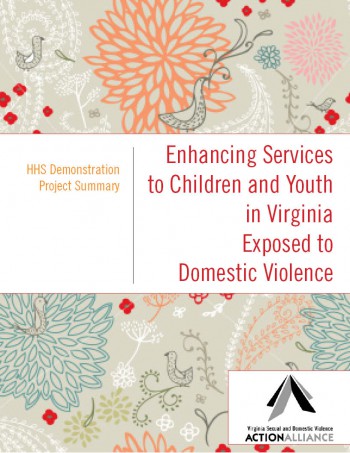Resources Library: Publications/Reports
Start a Search:
Domestic Violence Homicide Response Plan: A Toolkit for Domestic Violence Programs
Every survivor that domestic violence programs work with is a potential homicide victim. Advocates know this as they work with survivors, advocating on their behalf and building relationships with them and often their families. Domestic violence programs deal with the reality of knowing that a homicide could happen at any time, yet not allowing this knowledge to overpower their work with victims. When this most tragic violation occurs the traumatic impact is profound. This is felt by everyone - no matter the nature of their relationship with the victim. The needs of those closest to the victim, including their children, family and friends are of utmost importance. In addition, domestic violence programs, their clients and staff, and the communities they work within are deeply impacted. A homicide can change organizations and communities forever.
During this time, programs are asked to fulfill a variety of roles and often at the same time are dealing with their own sense of loss. An important part of responding and coping with these events is to realize there is no single “right” answer. Each of these tragedies is as unique as the human being whose life was taken, and all aspects of this person’s life and death need to be acknowledged, respected, and addressed as your program and community decide how to respond. It is also critical for the domestic violence program to utilize the tools and skills of trauma-informed care in their interactions with colleagues and others impacted by the death.
Produced by End Domestic Violence Wisconsin, the objective of this document is to provide a framework for domestic violence programs to develop a plan for how they will respond to a homicide in their community, whether the victim had been a client or not. Additionally, many of the elements of this plan can be adapted for use when programs experience a death of a client in shelter, as often the effects felt are similar.
Educational Rights of Homeless Children and Youth
We know that many of you work in programs work on behalf of children and youth everyday addressing a wide range of educational issues, including but not limited to, addressing safety needs associated with attending school, helping kids transition to schools, and general academic support. Recognizing that children and youth experiencing homelessness often have difficulty in school, there has been efforts to put policies and practices in place to protect the rights of all students and ensure access to services to support success in school.
In December 2015, the President signed into law the Every Student Succeeds Act of 2015 (ESSA), which ensures that education of homeless students. The law takes effect this October. Below are links to some basic fact sheets on this new law:
• Homeless Student Fact Sheet and Rights
• U.S. Department of Education Guidance. This document also provides specific guidance on protecting the privacy of homeless children exposed to or experiencing domestic violence.
• Information of Shelters and Advocates. This will also take to you to a link to find the Student Services Liaison in your community.
We hope this information helps you better understand the variety of rights of students, as well as provide you information on services in the community that are available to you to advocate on behalf of homeless students in your community.
The College of William and Mary the Education of Homeless Youth program for the Department of Education in Virginia. More information can be found on the program's website.
Effects of Racism on Domestic Violence Resources
This article examines how racism affects African-American women in terms of domestic violence. Racism alters how African American women receive treatment through domestic violence resources and how they perceive resources. Because of racism, African American women have specific concerns when making decisions about domestic violence relationships and what resources would be best for them.
Elder Abuse in Communities of Color
This 8-page resource published by the Women of Color Network as part of their Facts & Stats Collection provides a general overview of abuse later in life. It includes a chart of types of elder abuse, including physical abuse, emotional abuse, neglect, sexual abuse, financial exploitation, and healthcare fraud/abuse. Also included are sections highilighting specific issues and distinguishing dynamics that confront communities of color, including Latino/Hispanic, Native American/Alaskan Indian, Asian & Pacific Islander, and African American. Concludes with a great list of resources, both for elders and for communities of color.
Enhancing Services to Children and Youth in Virginia Exposed to Domestic Violence

A report on a 2-year (2006-2008) demonstration project funded by the Family Violence Prevention and Services Program.
Published by Virginia Sexual & Domestic VIolence Action Alliance, 2009.
56 pages.

